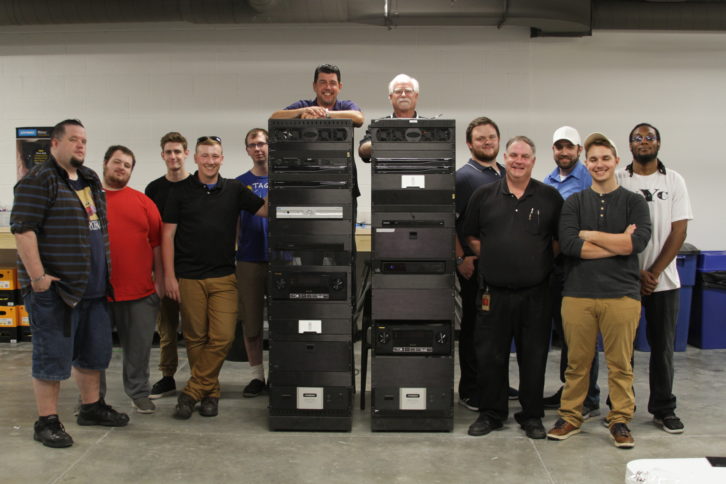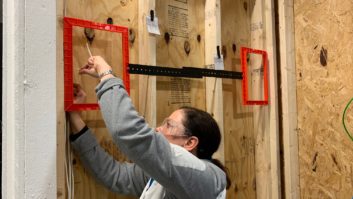Over the course of the summer, CEDIA HQ in Indianapolis hosted the inaugural CEDIA Electronic Systems Integration Technician Training program, an immersive occupational skills training program that stretched over 12 weeks. The students — recruited from trade schools, vocational and community colleges, and a variety of other sources — are new to the industry. The pilot program is an integral part of CEDIA’s strategic commitment to workforce development.

Jeff Gardner, a longtime CEDIA volunteer and primary instructor for this program, sums up the issue that integration firms are facing: “These smaller companies have people that are qualified to move up and do take on more responsibilities and become designers, engineers, lead technicians. But you can’t move them up unless you’ve got somebody to replace them. So we need people with the fundamentals to come in and be productive from day one.”
Gardner’s sentiment is echoed by another CEDIA volunteer instructor, Joe Whitaker. Whitaker, who’s also on the Global Board of Directors and lends a hand to the Workforce Development Working Group, adds, “Workforce development is one of the most serious issues within our industry today; finding early-level, trained technicians to come into our industry.” It’s a problem cited by many: In CEDIA’s 2018 U.S. Market Size and Scope of the Residential Technology Systems Industry report, finding and keeping trained employees was far and away the number one challenge facing U.S. integration firms of all sizes. (The issue was cited as a major pain point by 29 percent of those responding — competition from DIY products was a distant second at 15 percent.)
And for Whitaker there’s something of a personal element to it: “Somebody has to take ownership. Somebody has to say, for our industry, we need these entry-level people. We need to make sure that our industry, as a whole, lives on farther than just my lifetime in the biz.”
The Curriculum
As you’re likely aware, CEDIA already offers a fairly broad variety of entry-level training — the association’s Basic Boot Camp is a prime example. This program is unique, though, says Tommy Tabor, CEDIA’s director of workforce development: “This is vastly different from the Boot Camps and the one-off trainings we offer at our conferences and seminars. This is a 108-hour program that covers a very wide variety of skills. Our students have an opportunity to earn two industry-recognized credentials and connect with employers.”
The coursework, developed by CEDIA’s technical experts and education staff, draws from a variety of materials in CEDIA’s library of resources — a library that’s being updated constantly by CEDIA’s subject matter experts.
What’s more, CEDIA’s training facility has been approved by the state of Indiana, and, says Tabor, “The course itself is now a State of Indiana approved occupational skills training program and deemed compliant with federal and state Workforce Innovation and Opportunity Act (WIOA) policies.” That stamp of approval will be a huge help in expanding the program to other states, a process that’s already underway.
Related: CEDIA’s Size and Scope Report Reveals Market Opportunities
The Students
Nate Raab, who had experience in live sound engineering, was hired by a firm in Indy even before he’d finished his training. “My first day on the job, and I was using compression tools. I was terminating Cat6, right off the bat,” says Raab. It’s a direct result of the tactile approach that’s favored by the CEDIA’s volunteer instructors.
“I think the best part of this coursework is having hands-on experience in the rooms,” says Raab. “You make mistakes once, before you get onto the job site. Overestimating or underestimating the cable run before it matters is a mistake you should only have to make once, and I can make it here in this sandbox.”
Brett Jagger, another student who’s landed a gig, is enamored of the fact that he’s found a trade that matches his interests. “This has been a passion of mine for a long time,” says Jagger. “I mean, I have my own microphone for test calibration of my theater system at home. I’ve never really worked ‘in my passion’ before, and when I heard about this class opening up, it sounded like a great chance to do just that.”
And the experience is just as gratifying for the instructors as it is for the students. “I get to relive my youth in the industry,” says Joe Whitaker. “I’ve been in the industry for 20 years. I had to go out in the field and make the mistakes that these guys aren’t going to make.
“They’re going to walk out of the building ready to go. It took me years to be able to get to that level.”
Want more stories like this delivered to your inbox every day? Then sign up for the free Residential Systems eNewsletter here.






